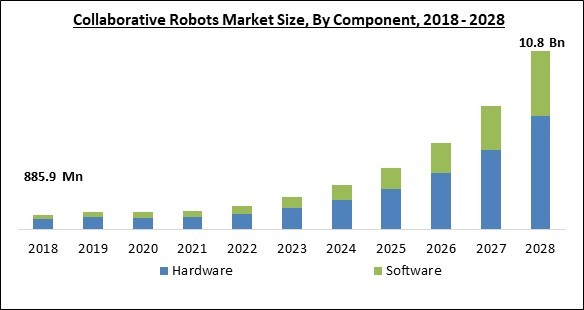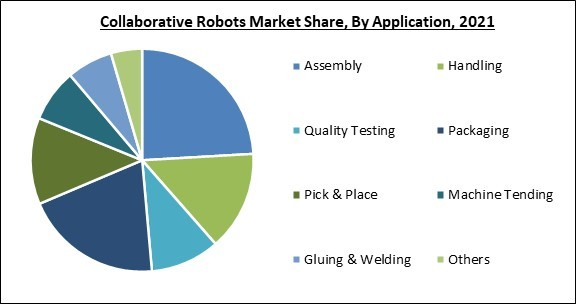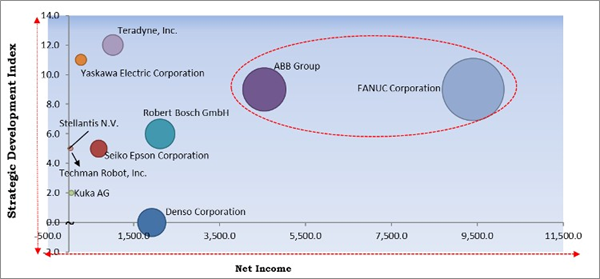The Global Collaborative Robots Market size is expected to reach $10.8 billion by 2028, rising at a market growth of 40.1% CAGR during the forecast period.
In a shared area or when people and robots are close to each other, a cobot, or collaborative robot, is designed for direct human-robot contact. In contrast to conventional industrial robot applications, which keep robots away from people, cobot applications allow for human interaction. Cobot safety may depend on soft edges, low weight materials, speed and force limitations built in, or sensors and software that enforce safe behaviour.
Robotics-using sectors are under constant pressure to lower operational costs while boosting production and upholding necessary standards of quality. For example, Yaskawa introduced the HC20XP Human-Collaborative Robot in March 2020. It includes precise hand-guided education for quick robot system setup.
The innovative 20 kg payload collaborative robot is ideal for applications where it is necessary for the robots to securely work alongside or close to humans. The first collaborative robot in its field to receive an IP67 rating is prepared for continuous usage in wet or splash-prone conditions. Additionally, the cost of, ease of use, and complexity of the available collaborative robots for training purposes are all decreasing.
This is expected to primarily give businesses a variety of options, which will boost interest in and demand for such robots. Because collaborative robots utilize the most recent sensors, plug-and-play technologies, and autonomous robot programming from CAD data, companies of all sizes and scales may remain competitive.
The major strategies followed by the market participants are Product Launches. Based on the Analysis presented in the Cardinal matrix; ABB Group and FANUC Corporation are the forerunners in the Collaborative Robots Market. Companies such as Robert Bosch GmbH, Teradyne, Inc. and Yaskawa Electric Corporation are some of the key innovators in Collaborative Robots Market.
The market research report covers the analysis of key stake holders of the market. Key companies profiled in the report include ABB Group, Robert Bosch GmbH, Denso Corporation, Seiko Epson Corporation, FANUC Corporation, Yaskawa Electric Corporation, Teradyne, Inc. (Universal Robots A/S), Techman Robot, Inc. (Quanta Storage, Inc.), Stellantis N.V. (Comau S.P.A), and Kuka AG (Midea Investment Holding Co., Ltd.)
In a shared area or when people and robots are close to each other, a cobot, or collaborative robot, is designed for direct human-robot contact. In contrast to conventional industrial robot applications, which keep robots away from people, cobot applications allow for human interaction. Cobot safety may depend on soft edges, low weight materials, speed and force limitations built in, or sensors and software that enforce safe behaviour.
Robotics-using sectors are under constant pressure to lower operational costs while boosting production and upholding necessary standards of quality. For example, Yaskawa introduced the HC20XP Human-Collaborative Robot in March 2020. It includes precise hand-guided education for quick robot system setup.
The innovative 20 kg payload collaborative robot is ideal for applications where it is necessary for the robots to securely work alongside or close to humans. The first collaborative robot in its field to receive an IP67 rating is prepared for continuous usage in wet or splash-prone conditions. Additionally, the cost of, ease of use, and complexity of the available collaborative robots for training purposes are all decreasing.
This is expected to primarily give businesses a variety of options, which will boost interest in and demand for such robots. Because collaborative robots utilize the most recent sensors, plug-and-play technologies, and autonomous robot programming from CAD data, companies of all sizes and scales may remain competitive.
COVID-19 Impact Analysis
An extremely contagious illness called COVID-19, which first appeared in China, has since spread over the entire world. This pandemic had a negative effect on the market in 2020 because China is regarded as a crucial market in the APAC region. Few of the market's top businesses are Universal Robots, ABB, and FANUC, have experienced a major decline in sales in 2020. The COVID-19 pandemic hindered and slowed the adoption of collaborative robots in a number of important industries, like electrical & electronics, metals and machining, and automotive.Market Growth Factors
High Rate of ROI in Comparison to Conventional Industrial Robots
The deployment of conventional industrial robots in production facilities calls for a complicated setup. These bigger robots demand a substantial number of fixed and linked engineering controls. Robotic arms, a variety of robot accessories, including controllers, grippers, end-effectors, and vision systems, are needed for these robots. Additionally, it needs additional gear like conveyors, fixtures, and safety fence because these robots cannot function inside the fencing like collaborative robots can.Increase in the Demand for Automation in the Healthcare Sector Due to the Pandemic
The global COVID-19 pandemic epidemic has accelerated the introduction of robots for automation in the healthcare industry. The healthcare sector has seen a dramatically increased emphasis on robotics. Robotic automated systems have been employed to disinfect operating rooms and patient rooms all across the pandemic. For instance, in Shenzhen Third People's Hospital in China, a robot named Aimbot patrols the hallways while dispensing disinfectant and maintaining the face-mask and social-distancing requirements.Market Restraining Factors
Restricted Payload and Speed of Cobots due to its Inherent Design
The maximum payload for most collaborative robots is typically 15 kg or less. As a result, the majority of collaborative robots are utilized for low payload applications. A rise in payload frequently causes a loss in the robot's repeatability and a rise owing to the increased sensors. Additionally, collaborative robots are built to move as quickly as a human arm, allowing for safe deployment next to a human. The mechanical design of cobots, notably the motorized robot joints, needs to take into account performance constraints.Component Outlook
By component, the collaborative robots market is segmented into Hardware and Software. The software segment recorded a significant revenue share in the collaborative robots market in 2021. A range of programming languages and software packages are accessible for creating collaborative robot applications. Every cobot has a customized programming system that is simple to use and enables the robot to rapidly and readily pick up new jobs. Additionally, there is simulator software available that may be utilized to develop a strong robot integration before moving forward with the project's implementation.Application Outlook
Based on application, the collaborative robots market is divided into Assembly, Pick & Place, Handling, Packaging, Quality Testing, Machine Tending, Gluing & Welding and Others. The metal equipment, electrical, and electronic industries where specialized spare components are put together and fitted in the finished product are projected to grow as the automotive sector expands. In addition, the expansion of the manufacturing sector across various nations of the world is expected to surge the growth of the segment during the forecast period.Vertical Outlook
By Vertical, the collaborative robots market is fragmented into Automotive, Electronics, Metals & Machining, Plastics and Polymers, Food and Beverages, Furniture & Equipment, Pharma and Others. The electronics segment recorded a significant revenue share in the collaborative robots market in 2021. A cobot has the ability to place chips into test equipment and then sort them. In addition, a cobot is ideal for these kinds of delicate products since it is so accurate and can operate with great delicacy owing to integrated sensors. The electronics industry is embracing collaborative robots.Payload Outlook
On the basis of Payload, the collaborative robots market is classified into Up to 5 Kg, up to 10 Kg and Above 10 Kg. The upto 5Kg segment acquired the highest revenue share in collaborative robots market in 2021. They optimize low-weight collaborative activities including picking, positioning, and testing while being lightweight and flexible. The introduction of sophisticated cobots with payloads in this range is creating new market expansion potential.Regional Outlook
Region-wise, the collaborative robots market is analyzed across North America, Europe, Asia Pacific and LAMEA. Asia Pacific emerged as the leading region in the collaborative robots market with the largest revenue share in 2021. This can be ascribed to the fact that companies are being compelled to automate the production processes in order to retain their cost advantage due to rising labour prices in APAC. The APAC region, particularly in nations like South Korea, China, and Taiwan, is a significant demand for collaborative robots from the automotive and electrical sectors. There is a higher need for the adoption of collaborative robots as a result of factors including growing wages, an ageing workforce on average, focus on the miniaturization trend in electronics, and the lightening trend in the automotive industry.Cardinal Matrix - Collaborative Robots Market Competition Analysis
The major strategies followed by the market participants are Product Launches. Based on the Analysis presented in the Cardinal matrix; ABB Group and FANUC Corporation are the forerunners in the Collaborative Robots Market. Companies such as Robert Bosch GmbH, Teradyne, Inc. and Yaskawa Electric Corporation are some of the key innovators in Collaborative Robots Market.
The market research report covers the analysis of key stake holders of the market. Key companies profiled in the report include ABB Group, Robert Bosch GmbH, Denso Corporation, Seiko Epson Corporation, FANUC Corporation, Yaskawa Electric Corporation, Teradyne, Inc. (Universal Robots A/S), Techman Robot, Inc. (Quanta Storage, Inc.), Stellantis N.V. (Comau S.P.A), and Kuka AG (Midea Investment Holding Co., Ltd.)
Strategies deployed in Collaborative Robots Market
; Partnerships, Collaborations and Agreements:
- Jul-2022: ABB came into a Memorandum of Understanding (MoU) with SKF, a Swedish bearing, and seal manufacturing company. This partnership aimed to detect and analyze solutions to enhance manufacturing capabilities and complement customers' better production efficiency.
- Mar-2022: KUKA came into a partnership with Wiksfors Technology, a visionary high-tech startup. This partnership aimed to provide an opportunity for house developers to get the advantage of the high knowledge and experience KUKA has in the automotive sector, integrated Wiksfors Technology’s comprehensive experience of data and robotics in the construction sector.
- Mar-2022: Bosch partnered GeekPlus Technology, a global technology company specializing in smart logistics. This partnership aimed to offer customers various products and solutions to boost the deployment of intelligent moving robots that is expected to drive the intelligent transformation of the manufacturing industry.
- Aug-2021: Epson Robots entered into an agreement with Advanced Industrial Products, a factory automation, and robotics supplier. Under this agreement, Epson’s cost-efficient, simple-to-use solutions integrated with AIP’s technical sales staff and engineers is expected to assist in opening the doors to develop new relationships in food, beverage, automotive, and medical markets.
- Jun-2021: Fanuc joined hands with Vention, the cloud-based manufacturing automation platform. This collaboration aimed to allow prospective system integrators, end-users, and training centers to develop and order complete, end-to-end robot cells directly from the Vention cloud platform.
- Apr-2021: Comau, subsidiary of Stellantis N.V. formed a partnership with Rockwell Automation, the world’s largest company dedicated to industrial automation and digital transformation. This partnership aimed to provide companies with overall vital tools to optimize manufacturing efficiencies via unified robot control solutions.
- Jul-2020: Universal Robots, subsidiary of Teradyne, Inc. formed a partnership with Phillips Corporation. Through Phillips’ comprehensive installed base and service network pan India, Universal Robots and Phillips India is expected to bring the advantages of democratized as well as flexible automation to SMEs, MSMEs, and OEMs as India is expected to emerge from the pandemic with a leaner but more productive and effective manufacturing industry.
; Product Launches and Product Expansions:
- Jul-2022: Comau, subsidiary of Stellantis N.V. unveiled its new Racer-5 Sensitive Environments (Racer-5 SE), a high-speed industrial robot. This robot is developed for the special and sensitive environment that characterizes the pharmaceutical, food and beverage, health and beauty, and electronics industries.
- Jun-2022: Epson Robots released a new line of SCARA robots developed to be a class above its high-end G Series. This product line includes GX Series with the GX4 and GX8 robots that is expected to manage payloads up to 4 kg (8.8 lb.) and 8 kg, (17.6 lb.), respectively. Through the latest GX Series, the GX4 and GX8 SCARA robots enable customers to operate robotic solutions powerfully and with a compact footprint.
- Jun-2022: Universal Robots, subsidiary of Teradyne, Inc. introduced its most powerful cobot, a 20kg-capacity arm. This arm is designed with a cut cycle time of up to 65% and is capable to manage heavier loads. In addition, this cobot weighs 64kg, which is expected to lead to a low moving mass and fast movements.
- Jun-2022: Techman Robot introduced its updated TM Robot S. The TM Robot S is developed for security and is apt for numerous of manufacturing applications. In addition, Techman Robot upgraded the dust and water resistance level of the S series and released the latest developed robot teach pendant to create teaching and deploying robots simpler and faster.
- Mar-2022: FANUC launched three new models, CRX-5iA, CRX-20iA/L, and CRX-25iA collaborative robots to its CRX line of collaborative robot arms. Through the addition of such new models, companies is expected to deliver the most extensive lineup of easy-to-use cobots accessible on the market.
- Feb-2022: Yaskawa Motoman unveiled two new collaborative robots, HC10DTP and HC20DTP, each of which has six axes. Hand-guided programming is expected to enable customers to direct teach points without a pendant, and an ISO standard tool flange and electrical connections use a plug & play approach for simple implementation of the robot system.
- Jul-2021: Yaskawa Electric introduced the latest collaborative robot “MOTOMAN-HC20SDTP” with a maximum load capacity of 20 kg. This latest model can also load heavy workpieces, which the traditional one could not.
- Feb-2021: ABB unveiled the new 6-axis GoFa CRB (Collaborative RoBot) 15000, which is expected to expand its collaborative robot portfolio. This product is expected to support the increasing demand for a collaborative robot that can manage heavier payloads to boost productivity and flexibility.
; Acquisitions and Mergers:
- Mar-2022: Bosch took over Kassow Robots, a Denmark-based developer of 7-axis collaborative robotic arms. This acquisition aimed to provide one-stop solutions, particularly for the consumer goods and mobility industry involving battery production and semiconductor production.
- Aug-2021: ABB acquired ASTI Mobile Robotics Group (ASTI), a leading global autonomous mobile robot (AMR) manufacturer. Under this acquisition, ABB is expected to be the only company to deliver a full automation product line of robots, AMRs, and machine automation solutions, from production to logistics to point of consumption.
Scope of the Study
Market Segments Covered in the Report:
By Application
- Assembly
- Handling
- Quality Testing
- Packaging
- Pick & Place
- Machine Tending
- Gluing & Welding
- Others
By Component
- Hardware
- Software
By Payload
- Up to 5kg
- Up to 10kg
- Above 10kg
By Vertical
- Automotive
- Food & Beverage
- Furniture & Equipment
- Electronics
- Plastic & Polymers
- Metal & Machinery
- Pharma
- Others
By Geography
- North America
- US
- Canada
- Mexico
- Rest of North America
- Europe
- Germany
- UK
- France
- Russia
- Spain
- Italy
- Rest of Europe
- Asia Pacific
- China
- Japan
- India
- South Korea
- Singapore
- Malaysia
- Rest of Asia Pacific
- LAMEA
- Brazil
- Argentina
- UAE
- Saudi Arabia
- South Africa
- Nigeria
- Rest of LAMEA
Key Market Players
List of Companies Profiled in the Report:
- ABB Group
- Robert Bosch GmbH
- Denso Corporation
- Seiko Epson Corporation
- FANUC Corporation
- Yaskawa Electric Corporation
- Teradyne, Inc. (Universal Robots A/S)
- Techman Robot, Inc. (Quanta Storage, Inc.)
- Stellantis N.V. (Comau S.P.A)
- Kuka AG (Midea Investment Holding Co., Ltd.)
Unique Offerings from the Publisher
- Exhaustive coverage
- The highest number of Market tables and figures
- Subscription-based model available
- Guaranteed best price
- Assured post sales research support with 10% customization free
Table of Contents
Chapter 1. Market Scope & Methodology
Chapter 2. Market Overview
Chapter 3. Competition Analysis - Global
Chapter 4. Global Collaborative Robots Market by Application
Chapter 5. Global Collaborative Robots Market by Component
Chapter 6. Global Collaborative Robots Market by Payload
Chapter 7. Global Collaborative Robots Market by Vertical
Chapter 8. Global Collaborative Robots Market by Region
Chapter 9. Company Profiles
Companies Mentioned
- ABB Group
- Robert Bosch GmbH
- Denso Corporation
- Seiko Epson Corporation
- FANUC Corporation
- Yaskawa Electric Corporation
- Teradyne, Inc. (Universal Robots A/S)
- Techman Robot, Inc. (Quanta Storage, Inc.)
- Stellantis N.V. (Comau S.P.A)
- Kuka AG (Midea Investment Holding Co., Ltd.)
Methodology

LOADING...











